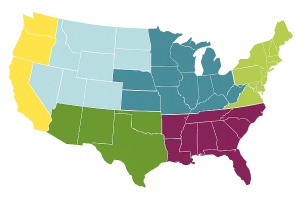Utah Native Plants, State Flower & State Bird
Posted By American Meadows Content Team on Sep 27, 2012 · Revised on Oct 26, 2025

Knowing your location helps us recommend plants that will thrive in your climate, based on your Growing Zone.
Posted By American Meadows Content Team on Sep 27, 2012 · Revised on Oct 26, 2025
Native plants are adaptable, low-maintenance, and beautiful. They are the best choice for habitat-friendly gardens and thriving ecosystems. Find top picks for native plants in your state - and learn about your state bird and state flowers!
Follow Along With More Of Our Guides
Hello native plant enthusiasts! In the list below, you will find popular native plants and wildflower seeds, available from American Meadows, that have a native distribution in your state. You’ll also find information about your state bird, state flower, and state wildflower!
Grow our Native West Wildflower Seed Mix.
Black Eyed Susan or Gloriosa Daisy (Rudbeckia hirta)
Yellow Prairie Coneflower (Ratibida columnifera)
Butterfly Weed (Asclepias tuberosa)
Swamp Milkweed (Asclepias incarnata)
Firewheel (Gaillardia pulchella)
Wild Strawberry (Fragaria virginiana)
Firewheel (Gaillardia pulchella)
Blanket Flower (Gaillardia aristata)
Wild Bergamot (Monarda fistulosa)
Obedient Plant (Physostegia virginiana)
Red Cardinal Flower (Lobelia cardinalis)
Big Bluestem (Andropogon gerardii)
Little Bluestem (Schizachyrium scoparium)
Tufted Hair Grass (Deschampsia cespitosa)
Yellow Prairie Grass (Sorghastrum nutans)
New England Aster (Symphyotrichum novae-angliae)

California Gull ~ Larus californicus
In 1848, Mormon pioneers fought a host of black locusts that devoured their precious crops. A thousand miles from supplies, their struggling settlement near the Great Salt Lake seemed doomed. Then, suddenly, flocks of California Gulls descended on their fields and began eating the insects. These Gulls are common along the Pacific Coast in winter, and inland along the prairies in breeding season. Today, two gilded California Gulls flank a popular monument to their species in Salt Lake City.
Sego Lily ~ Calochortus nuttallii
The Ute Indians used the bulblike roots of the Sego Lily as part of their food supply. The Sego Lily grows from a short bulblike fleshy stem called a corm, which grows underground. The plant’s few bluish-green leaves are long and narrow. The flowers are about two inches across, and two or three of them may be borne on the stiff slender stem. Its lovely hues and markings have earned this lily the name mariposa, a Spanish word meaning butterfly.
From The Wildflowers of the 50 States U.S. stamps issued July 24, 1992:

